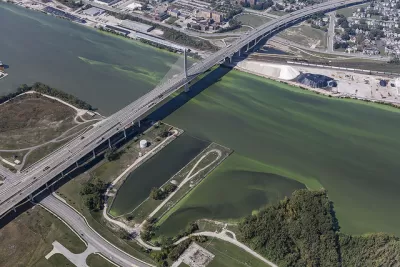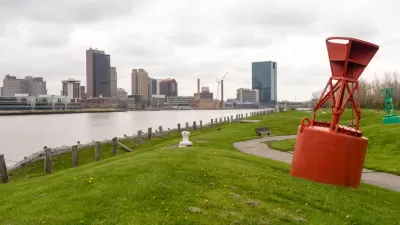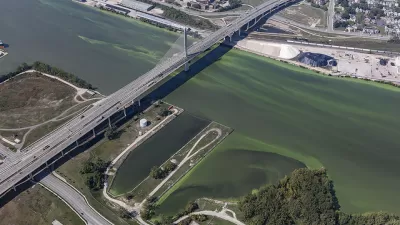The algae bloom in Lake Erie has spread to cover much of the edge of Lake Eerie near Toledo, but toxins remain low where local communities draw drinking water supply.

Jugal K. Patel and Yuliya Parshina-Kottas provide in-depth, feature coverage of the infamous Lake Erie algae bloom, which made news in 2014, but has recently been turning Lake Erie and the Maumee River green and potentially toxic again.
The risk of algae blooms comes from the likelihood that they produce toxins like microcystis. "Dangerous levels of the toxin caused Toledo, Ohio, to shut down the drinking water supply of a half-million residents for three days in 2014," according to the article. Some 3 million residents rely on the Central Basin of Lake Eerie for drinking water, so there's a very essential risk, but tourism for recreation like fishing and beach-going are also at risk when algae blooms grow.
And the algae blooms have grown in recent decades, due to the impact of the regional agricultural industry. "According to one study by the Carnegie Institute for Science and Stanford University , most of the increase in the size of the blooms can be attributed to a rise in the amount of dissolved phosphorus flowing into the lake," write Patel and Parshina-Kottas.
The article is supplemented with lots of images and infographics to illustrate the scale of the environmental disaster persisting around Lake Erie.
FULL STORY: Miles of Algae Covering Lake Erie

Maui's Vacation Rental Debate Turns Ugly
Verbal attacks, misinformation campaigns and fistfights plague a high-stakes debate to convert thousands of vacation rentals into long-term housing.

Planetizen Federal Action Tracker
A weekly monitor of how Trump’s orders and actions are impacting planners and planning in America.

Chicago’s Ghost Rails
Just beneath the surface of the modern city lie the remnants of its expansive early 20th-century streetcar system.

Bend, Oregon Zoning Reforms Prioritize Small-Scale Housing
The city altered its zoning code to allow multi-family housing and eliminated parking mandates citywide.

Amtrak Cutting Jobs, Funding to High-Speed Rail
The agency plans to cut 10 percent of its workforce and has confirmed it will not fund new high-speed rail projects.

LA Denies Basic Services to Unhoused Residents
The city has repeatedly failed to respond to requests for trash pickup at encampment sites, and eliminated a program that provided mobile showers and toilets.
Urban Design for Planners 1: Software Tools
This six-course series explores essential urban design concepts using open source software and equips planners with the tools they need to participate fully in the urban design process.
Planning for Universal Design
Learn the tools for implementing Universal Design in planning regulations.
planning NEXT
Appalachian Highlands Housing Partners
Mpact (founded as Rail~Volution)
City of Camden Redevelopment Agency
City of Astoria
City of Portland
City of Laramie




























